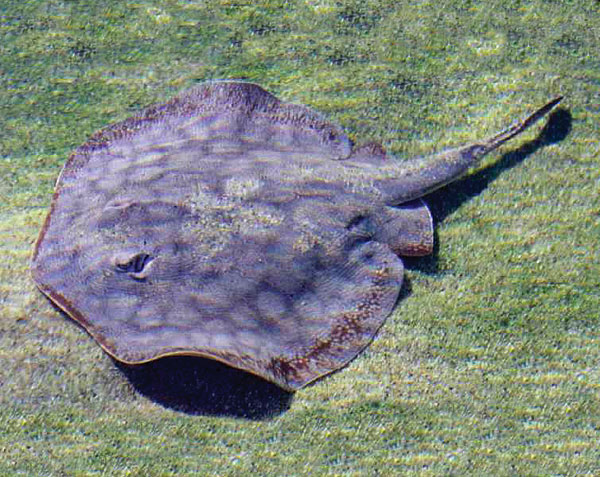A North Carolina aquarium has reported that a round stingray named Charlotte, the only member of her species living in her tank, is pregnant. An animal becoming pregnant without a mate (and in this case, at an inland aquarium hundreds of miles from the ocean, and thousands of miles from any wild round stingrays) is a pretty interesting event!
Troublingly, some aquarium spokespeople have claimed on their social media that a possible explanation is that one of the male sharks in Charlotte’s tank mated with her, which has been widely shared in news outlets around the world. This is scientifically preposterous, and has inspired widespread (and deserved) mockery. They’ve even doubled down on this absurd claim, criticizing experts who called out this pseudoscience and saying “Just because something has not happened or has not been documented does not make it impossible. Science is discovery. And besides, none of us know what has happened in the big ocean because we are not always there.” Oy.

A round stingray, image courtesy Aquarium of the Pacific
Let’s be clear: A shark absolutely cannot get a stingray pregnant.
Closely related species of animals (including sharks) can hybridize, but sharks and stingrays are simply not closely related enough for this to be remotely possible.
“Hybrid animals can exist between closely related species, like mules, a cross between a horse and a donkey, which are in the same genus and separated by about 2 million years of evolution,” Dr. Noah Bressman, an Assistant Professor of Physiology at Salisbury University told me. “But sharks and rays are separated by about 300 million years of evolution- about as much as time when the ancestors from humans diverged from the ancestors of snakes, which means a shark knocking up a stingray is about as likely as a human knocking up a snake. With more time for evolution to occur, the odds of creating a hybrid go down. Horses and donkeys are a lot more similar to each other than sharks and rays are in terms of the number and size of their chromosomes, the size and shape of their reproductive organs, and the size and shape of their eggs and sperm.”
(And yes, there is an animal whose common name is “shark ray,” but it is absolutely a ray and not a combination of a shark and a ray, just as “whale sharks” are sharks and are not shark-whale hybrids).
Sharks and their relatives have reproduced without a male before.
There are two main ways that this can happen. One is parthenogensis, a form of asexual reproduction. A female becomes pregnant despite not mating with a male, and the babies, instead of having a combination of the DNA of mom and dad, just have mom’s DNA. This has been documented in lots of species including bonnethead sharks (where it was first described more than 15 years ago,) zebra sharks, blacktip sharks, and sawfish.
“Parthenogenesis is essentially self-cloning,” Dr. Toby Daly-Engel, the Director of the Shark Conservation Lab at the Florida Institute of Technology, told me. “When there are no males around for a long period of time, a female animal can essentially self-fertilize her eggs in order to have offspring. We can detect parthenogenesis with genetic testing, because the baby usually has the exact same DNA as mom. Since DNA testing became routine, we’ve discovered that parthenogenesis is incredibly common in nature, even among large, complex vertebrates like sharks and rays. It’s not a great long-term evolutionary strategy, because clones lack the genetic diversity that is crucial for long-term species’ survival. But being kept in an aquarium with no other rays seems to be the kind of environment that can trigger parthenogenesis, because we’ve seen it a few times now.”
Additionally, some female sharks have been shown to store sperm inside their bodies after a mating event, not becoming pregnant until much later. The record for this is just under four years, which means that it’s possible that an animal can mate in the wild, be captured and placed in an aquarium, and become pregnant later. It’s also possible that a long-gone male from the tank could have mated with a female, who stored the sperm for a very long time.
Conclusions
Sharks and rays are scientifically fascinating animals that have long inspired the public imagination. Really cool adaptations like parthenogenesis can absolutely be a part of this wonder and awe, if properly communicated.
Unfortunately, poor handling of this story has made it likely that we are on track for another year where the most-shared news story about a shark or ray is pseudoscientific nonsense, rather than about their dire conservation needs, their importance to marine and coastal ecosystems, or amazing new discoveries about them.
As a longtime supporter of zoos and aquariums and the roles they play in public science education, I am especially troubled by some of the public-facing communications here. If your goal is sharing knowledge with the public, there’s value in gaining accurate knowledge about the subject yourself first. Sharing wrong facts is not “raising awareness” or educating the public, and falsely claiming “anything is possible, don’t trust the experts” is, to put it mildly, not helping the ocean.
Further Reading: Dr. Kady Lyons of the Georgia Aquarium, an expert in reproductive biology of sharks and their relatives who studied round stingrays for some of her graduate work, has an excellent and extensive interview in this Huffington Post article.
thank you for your sane and intelligent contribution to this topic